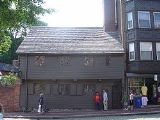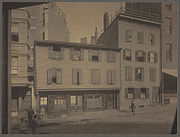
Paul Revere House
Encyclopedia

Colonial America
The colonial history of the United States covers the history from the start of European settlement and especially the history of the thirteen colonies of Britain until they declared independence in 1776. In the late 16th century, England, France, Spain and the Netherlands launched major...
home of American patriot Paul Revere
Paul Revere
Paul Revere was an American silversmith and a patriot in the American Revolution. He is most famous for alerting Colonial militia of approaching British forces before the battles of Lexington and Concord, as dramatized in Henry Wadsworth Longfellow's poem, Paul Revere's Ride...
during the time of the American Revolution
American Revolution
The American Revolution was the political upheaval during the last half of the 18th century in which thirteen colonies in North America joined together to break free from the British Empire, combining to become the United States of America...
. It is located at 19 North Square
North Square (Boston, Massachusetts)
North Square in the North End, Boston of Boston, Massachusetts sits at the intersection of Moon, Prince, North, Garden Court, and Sun Court Streets. Paul Revere lived here, as did other notables in the 17th and 18th centuries. Prior to July 4, 1788, the area was known as Clark's Square.-History:In...
, Boston
Boston
Boston is the capital of and largest city in Massachusetts, and is one of the oldest cities in the United States. The largest city in New England, Boston is regarded as the unofficial "Capital of New England" for its economic and cultural impact on the entire New England region. The city proper had...
, Massachusetts
Massachusetts
The Commonwealth of Massachusetts is a state in the New England region of the northeastern United States of America. It is bordered by Rhode Island and Connecticut to the south, New York to the west, and Vermont and New Hampshire to the north; at its east lies the Atlantic Ocean. As of the 2010...
, in the city's North End, and is now operated as a nonprofit museum by the Paul Revere Memorial Association. A small admission fee is charged.
History
The original three-story house was built about 1680. It occupied the former site of the Second Church of Boston's parsonage, home to Increase MatherIncrease Mather
Increase Mather was a major figure in the early history of the Massachusetts Bay Colony and Province of Massachusetts Bay . He was a Puritan minister who was involved with the government of the colony, the administration of Harvard College, and most notoriously, the Salem witch trials...
and Cotton Mather
Cotton Mather
Cotton Mather, FRS was a socially and politically influential New England Puritan minister, prolific author and pamphleteer; he is often remembered for his role in the Salem witch trials...
, which was destroyed in the Great Fire of 1676. Its first owner was Robert Howard, a wealthy merchant. His L-shaped townhouse contained spacious rooms and would have been enhanced by exterior features such as a second-floor overhang and casement windows.
As is typical of early Massachusetts Bay timber construction, the main block of the three-story dwelling consisted of four structural bays demarcated by heavy framing posts and overhead beams. The larger ground-floor room in this main block was dominated by its chimney bay and adjoining lobby entrance. Although some contemporary Boston houses had separate kitchen buildings, the two-story extension behind the Revere House was typical. As the Revere House was set quite close to neighbors, its double casement windows were installed in the rear elevation rather than the more common placement in a gable
Gable
A gable is the generally triangular portion of a wall between the edges of a sloping roof. The shape of the gable and how it is detailed depends on the structural system being used and aesthetic concerns. Thus the type of roof enclosing the volume dictates the shape of the gable...
.
Around the middle of the eighteenth century, the Paul Revere House went through two major renovations. First, the roofline facing the street was raised substantially to bring the house in line with the Georgian architectural style
Georgian architecture
Georgian architecture is the name given in most English-speaking countries to the set of architectural styles current between 1720 and 1840. It is eponymous for the first four British monarchs of the House of Hanover—George I of Great Britain, George II of Great Britain, George III of the United...
that had become prevalent at that time (the roofline was returned to its original pitch, albeit without a gable, by the restorers in 1907-1908, which gave rise to a commonly-held misconception that the attic had been removed). Second, a two-story lean-to
Lean-to
A lean-to is a term used to describe a roof with a single slope. The term also applies to a variety of structures that are built using a lean-to roof....
was added in the ell between the two 17th-century portions of the house (this lean-to was removed by the restoration in 1907-1908).
Paul Revere owned this house from 1770–1800, although he and his family may have lived elsewhere for periods in the 1780s and 1790s. It is believed that during the Revere occupancy the rear chimney was added (c. 1790) including the kitchen that visitors see in the first room they enter.

Despite the substantial renovation process which returned the house to its conjectured appearance around 1700, ninety percent of the structure (including two doors, three window frames, and portions of the flooring, foundation, inner wall material and raftering) is original to 1680, though none of the window glass is original. Its heavy beams, large fireplaces, and absence of interior hallways are typical of colonial living arrangements. The two chambers upstairs contain several pieces of furniture believed to have belonged to the Revere family.
Immediately adjacent (across the entry courtyard, the original site of the John Barnard House) is the brick Pierce-Hichborn House
Pierce-Hichborn House
The Pierce-Hichborn House is an early Georgian house located at 19 North Square, Boston, Massachusetts. It is immediately adjacent to the Paul Revere House and is now operated as a nonprofit museum by the Paul Revere Memorial Association...
, built about 1711 as an early Georgian house, and also operated as a nonprofit museum by the Paul Revere Memorial Association.
Further reading
- Nina Zannieri. Report from the Field: Not the Same Old Freedom Trail: A View from the Paul Revere House. The Public Historian, Vol. 25, No. 2 (Spring, 2003), pp. 43–53.
External links
- Boston National Historical Park Official Website
- Paul Revere House Website
- Historic American Buildings Survey, Library of Congress. Paul Revere House, 19 North Square, Boston, Suffolk County, MA
- Google news archive

